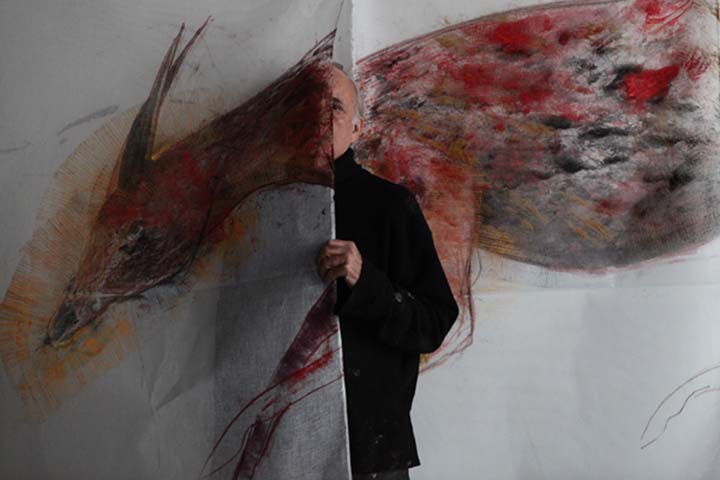Marshall Arisman: The Ayahuasca Cave

Marshall Arisman, longtime chair of the MFA Illustration as Visual Essay Department at the School of Visual Arts, and a co-founder of American Illustration, sent this photo of new work that will be on view this week in New York City.
Intrigued, I arranged for a studio visit. At the appointed hour, I found myself in Marshall’s crowded studio amid sculpted heads of what seemed like shamanistic creatures, part man, part animal. In the center of the space was a plinth with dozens of clay heads of indeterminate origin. In front of a large painting of a primitive figure was a hellish, life-size hound with snarling jaws and a fearsome pent-up energy. All around were more paintings from the artist’s Ayahuasca Series as well as two brightly lighted paintings on thin white fabric.
These are the pieces that will be installed at the Sacred Gallery this week. I asked if they were inspired by the famous cave paintings in the Dordogne region of France, and this is the story that unfolded:
“The year was 1970. With no specific destination in mind, I rented a car in Paris and drove south. My wife, accustomed to my purposeless wanderings looked at the map. ‘We could go see the cave drawings,’ she said.
“The Dordogne region of France houses Paleolithic art done over 17,000 years ago. Lascaux, the region’s most famous cave was closed to the public in 1963. The carbon dioxide produced by 1,200 visitors a day at Lascaux had visibly damaged the paintings. By 1970 numerous other caves were still open to the public but largely unattended.
“I pulled into the parking lot of Grotte de Font-de Gaume, a showplace of Magdalenian engravings and paintings from around 14000 B.C. A lone Volvo sat baking in the noon-day sun. Six Swedish tourists wearing double-knit Irish sweaters were hunkered down near the cave entrance. The tour guide motioned for us to join the group. Fifty meters into the cave we squeezed, single file, through a meter wide passageway covered in drawings. The guide, raising his lantern, encouraged us to 'pet the animals.'
"The contour of the limestone walls created bas reliefs. Rib cages swelled, legs receded and skulls floated under the skin. Gasping for air, animal forms emerged from the cracks in the limestone as if giving birth. Accompanied by polychrome bisons, horses, and deer rendered in black and ochre, we entered the main chamber of the cave. A frieze of five bison dominated the 50-meter-long gallery surrounded by panels of superimposed drawings done by successive generations of cave artists. I stood in awe. We had blundered into a sacred place where we not only didn’t belong but were not welcome.
“As my eyes scanned the wall the animals began to move. Feeling disorientated I placed the palm of my hand on a life-size bison to steady myself. Despite the drop in temperature the animal form generated tremendous heat. The energy put into the drawing by the shaman was still there. Many people believe that our ancestors are watching us without being seen. I felt, I knew that the surface of that cave was a curtain between the material world and the Spirit world. The shaman of this tribe, with the aid of an animal helper, had passed through the wall and upon returning illustrated his journey on the cave wall. Members of the tribe could see the journey with their eyes and feel the energy of the journey with their hands.
“To quote David Lewis-Williams, ‘One of the uses of the caves was for some sort of vision questing. Certainly, the sensory deprivation afforded by the remote, silent and totally dark chambers, such as the Diverticule of the Felines in Lascaux and the Horses Tail in Altamira induces altered states of consciousness. In their various stages of altered states, questers sought, by sight and touch, in the folds and cracks of the rock face, visions of powerful animals. It is as if the rock were a living membrane. Behind the membrane lay a realm inhabited by spirit animals and spirits themselves.’
“I emerged from the cave slightly terrified. I had tapped into an ancient memory. It would take another thirty years to try and visualize that experience.”
Opening reception, Thursday, April 5, 7-10 pm. Sacred Gallery 424 Broadway (between Canal and Howard Streets), 2nd Floor, NY, NY. The exhibition continues through April 30th.
04022012


